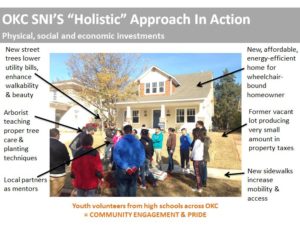Oklahoma City, Oklahoma
By 2010, so many people had moved out of the core of Oklahoma City that neighborhoods were suffering from apathy, vacancy, and blight. The city assisted people with home repairs and made some small improvements, but these efforts were too scattered to have an impact. Recognizing the problem, the city council and the city manager, James Couch, asked staff to choose areas where the city could work alongside neighborhood associations and strategically plan revitalization.
In 2012 three neighborhoods were selected to take part in the newly formed Strong Neighborhoods Initiative (SNI), which would apply physical, social, and economic investments and tip them toward self-sufficiency. These are: Classen Ten Penn, Classen’s North Highland Parked and Culbertson’s East Highland (map above).
The neighborhood associations were committed, and the Neighborhood Alliance of Central Oklahoma also became a partner. Neighbors, community stakeholders, schools, and organizations were brought together and with the help of partner agencies, existing community development programs were modified, and several new programs were developed.
Public/Private Partnerships Play Key Role
The SNI program required participation and commitment from neighborhood associations, residents, schools, and businesses within the targeted areas. Public/private partnerships play a key role in nearly every project and program. And city management played an instrumental role in supporting staff’s innovative ideas and unconventional partnerships.

Partners and teamwork on display in Oklahoma City.
“City managers can take a longer, more strategic view of programs like SNI. It may take more than one election cycle to turn around a neighborhood that has experienced significant decline,” said Couch. “This partnership means we all have an opportunity to work hand-in-hand on neighborhood specific solutions that reduce crime, improve housing, and expand employment opportunities. The future of urban living in Oklahoma City depends on revitalizing and empowering neighborhoods like these.”
The primary concerns of neighbors were crime, decreasing property values, decreasing owner-occupied housing, and general lack of investment. Tracking these indicators allows SNI to evaluate the programs, which began in 2013 with funding from the city plus Community Development Block Grant (CDBG) and HOME funds from the U.S. Department of Housing and Urban Development, according the senior planner, Shannon Entz, who manages SNI program.
Residents were also concerned about safe afterschool activities, which led to a partnership with the city schools and the Oklahoma Afterschool Network to create the STEAM afterschool program (science, technology, engineering, arts, and math), which was launched in the summer of 2014. Other early projects were chosen and purposefully implemented in visible locations to garner neighborhood engagement and to catalyze market confidence and private investment.
Additional SNI Results
• Increased and more diversified membership in all three neighborhood associations.
• A social media campaign that shares information and photos of events and projects. [links]
• A steady increase in private investment. The city’s overall goal is a 4-to-1 ratio of non-city to city dollars by 2018. In August 2016, the city was ahead of projections at a 3-to-1 ratio.
• More than $8 million in private investments in SNI neighborhoods since 2013.
• Classen Ten Penn saw a 33% decrease in crime and average home sales prices increased by more than 130% between 2011 and 2015.
• Classen’s North Highland Parked average home sales price increased 170% between 2011 and 2015.
• Culbertson’s East Highland has seen the average home sales price increase 14% and crime decrease 10% between 2011 and 2015.
• More than 800 students take part in the STEAM program, and math scores increased up to 20 points in the first summer.
More to Come
As of late 2016, SNI had the following projects planned, underway, or completed:
• 25 single-family, affordable, and market-rate homes constructed
• 40 blocks of new sidewalks and ADA ramps for access to schools, parks, transit, and services
• 4 new EMBARK bus shelters with neighborhood association logos
• 37 owner-occupied homes rehabilitated in collaboration with Oklahoma City’s Housing Rehabilitation Department, most of which are owned by seniors and female-headed households
• 1 new park with public art, Freemont Harn Gardens, built in Classen’s North Highland Parked
• 2 existing neighborhood parks to be improved between 2016 and 2018
• 179 street trees planted to beautify and provide tree canopy in urban areas
• 36 hazardous trees removed to maintain a healthy urban forest
• 27 neighborhood identification signs installed
• 23 families utilizing legal help to clear up titles for abandoned homes
• 3 walkability studies conducted in conjunction with SNI neighborhood fifth graders
• 1 mural commissioned to beautify McKinley Park in the Classen Ten Penn neighborhood.
“The Strong Neighborhoods Initiative provides resources to develop partnerships that enable us to implement the city council’s strategic priority of promoting thriving neighborhoods,” said Couch. The SNI program has been featured in several local articles. See more updates on the SNI social media channels:
Meet the Manager

